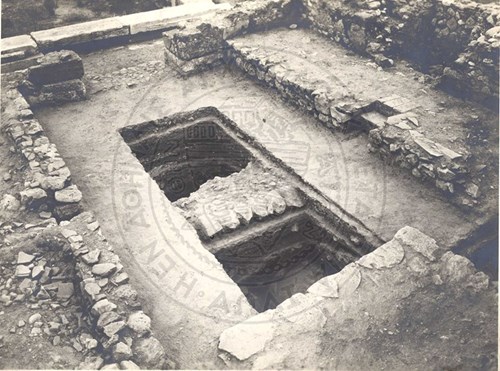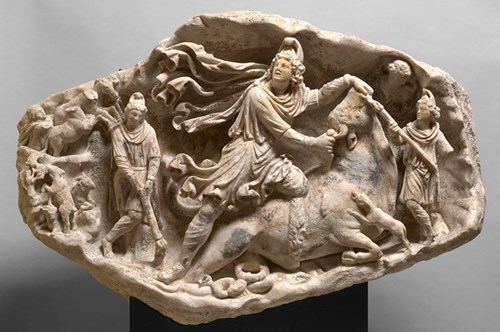Demeter’s new neighbour
The Mithraeum to the south of the Sacred House commemorates a period of religious crisis throughout the Roman Empire. Since the establishment of the sanctuary, Demeter and Persephone were the sole recipients of the adoration of the faithful who came to Eleusis. As the empire entered a prolonged stretch of military and social upheaval, some people sought comfort and spiritual guidance in the arms of another deity, Mithras.
According to Plutarch, the first seeds of the cult of Mithras were planted in the Roman Empire by sailors under the command of Pompey, who came into contact with the worship of the god in the region of Mount Olympus in Asia Minor. The cult spread throughout the western half of the Roman Empire and achieved notable popularity among soldiers on the frontier. The eastern part of the empire proved more hesitant to accept a deity with such overt Persian elements and mithraea are rather rare in Greece and Asia Minor. There are almost no Mithraic literary sources regarding the substance of the cult but it seems that the image that would take pride of place in every mithraeum was that of Mithras slaying a bull in a cave with stars on the ceiling. A dog and a snake drink the blood of the bull, while a scorpion bites its testicles. On either side of the image stand the torchbearers: Cautes with his torch raised and Cautopates with his lowered. The Sun (Sol) and the Moon (Luna) witness the bull-slaying.

Most mithraea have a similar plan designed to recreate the passage of the soul across the celestial spheres. In contrast to the rich exterior decoration of the standard Greek temple, most mithraea attempt to recreate the cave of the bull-slaying scene. The building’s exterior practically does not matter. The average mithraeum had seating for fifteen or twenty people but there was probably room for forty worshipers if most of them remained standing. The mithraeum in Eleusis is a simple rectangular room with a marble propylon.

We do not know who built the mithraeum in Eleusis but the story of the last hierophant may provide some clues as to the date. The Greek sophist Eunapius (347 - after 414) knew about a prophecy regarding the impending destruction of the sanctuary of Demeter and the election to the office of chief priest of the Eleusinian Mysteries of an illegitimate hierophant who was neither an Athenian citizen nor a member of the priestly family of the Eumolpidae. Even worse, he would have no right to the office because he worshipped foreign gods. Indeed, when the last legitimate hierophant passed away in the late 4th century, the office fell into the hands of a priest of Mithras from Thespiae, who may have decided to build the Eleusinian mithraeum.
Bibliography
Αλεξοπούλου-Μπαγιά, Πόλλυ. Ιστορία της Ελευσίνας: Από την Προϊστορική μέχρι τη Ρωμαϊκή περίοδο, Ελευσίνα: Δήμος Ελευσίνας, 2005.
Mylonas, George. Eleusis and the Eleusinian Mysteries, London: Routledge, 1962.
Papangeli, Kalliopi.Eleusis: the archaeological site and the museum, Athens: Omilos Latsi, 2002.
Walsh, David. The Cult of Mithras in Late Antiquity: Development, Decline and Demise ca. A.D. 270-430, Leiden: Brill, 2018.
Image source: The Archaeological Society at Athens
Image link: https://bit.ly/2Z9wf8B


